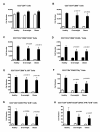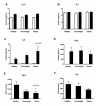Overweight and obese adult humans have a defective cellular immune response to pandemic H1N1 influenza A virus
- PMID: 23512822
- PMCID: PMC3695020
- DOI: 10.1002/oby.20383
Overweight and obese adult humans have a defective cellular immune response to pandemic H1N1 influenza A virus
Abstract
Objective: Obese adults have a greater risk of morbidity and mortality from infection with pandemic H1N1 influenza A virus (pH1N1). The objective of the present study was to elucidate the specific mechanisms by which obesity and overweight impact the cellular immune response to pH1N1.
Design and methods: Peripheral blood mononuclear cells from healthy weight, overweight, and obese individuals were stimulated ex vivo with live pH1N1 and then markers of activation and function were measured using flow cytometry and cytokine secretion was measured using cytometric bead array assays.
Results: CD4(+) and CD8(+) T cells from overweight and obese individuals expressed lower levels of CD69, CD28, CD40 ligand, and interleukin-12 receptor, as well as, produced lower levels of interferon-γ and granzyme B, compared with healthy weight individuals, suggesting deficiencies in activation and function are indicated. Dendritic cells from the three groups expressed similar levels of major histocompatibility complex-II, CD40, CD80, and CD86, as well as, produced similar levels of interleukin-12.
Conclusions: The defects in CD4(+) and CD8(+) T cells may contribute to the increased morbidity and mortality from pH1N1 in obese individuals. These data also provide evidence that both overweight and obesity cause impairments in immune function.
Copyright © 2013 The Obesity Society.
Figures




References
-
- World Health Organization WHO Factsheet 311: Obesity and overweight. 2012 May;2012
-
- Louie JK, Acosta M, Samuel MC, et al. A novel risk factor for a novel virus: obesity and 2009 pandemic influenza A (H1N1) Clin Infect Dis. 2011;52:301–312. - PubMed
-
- Centers for Disease Control and Prevention (CDC) Intensive-care patients with severe novel influenza A (H1N1) virus infection - Michigan, June 2009. MMWR Morb Mortal Wkly Rep. 2009;58:749–752. - PubMed
Publication types
MeSH terms
Grants and funding
LinkOut - more resources
Full Text Sources
Other Literature Sources
Medical
Research Materials

